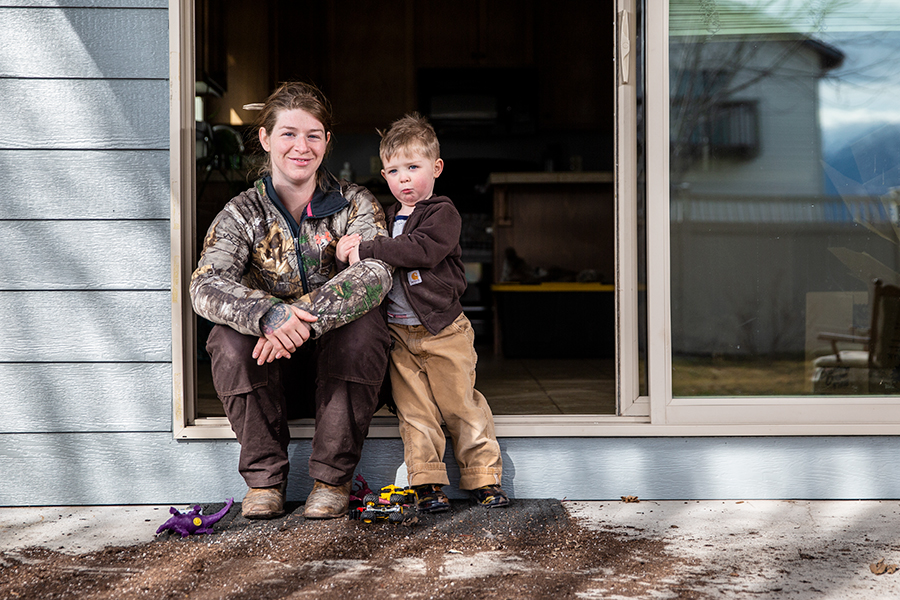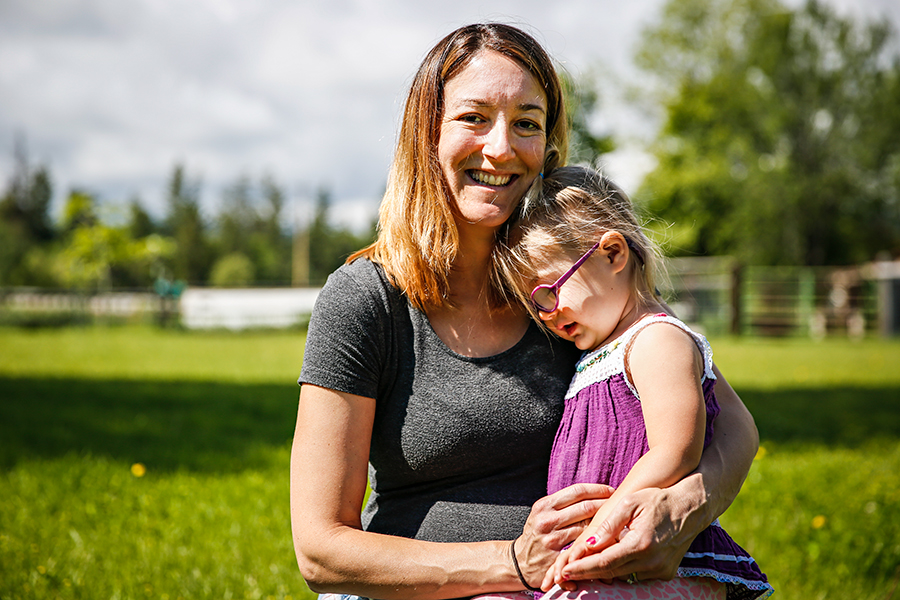As a virulent global pandemic swept into Montana, triggering school and business closures across the state, 2-year-old Maya of Kalispell collected duck eggs and built a hotel for bugs.
It’s not that Maya didn’t care about the upheaval caused by the COVID-19 pandemic. She cared a lot. The daycare she attended three days a week closed. So did the library where she frequented educational activities with her friends. Her schedule was upended just as much as anyone’s.
“I explained that people are sick and we are not allowed to go to the park,” said Maya’s mother, local business owner Katie Miller. “She seemed to accept it.”
The Millers were among countless families with small kids, in Montana and nationwide, to suddenly find themselves living on an island without access to other children, critical resources and beloved relatives. Even now as daycares reopen and families transition back to their pre-pandemic routines, child-development experts and parents alike worry about the long-term impacts on young developing minds from the prolonged isolation, while also trying to savor the unexpected lessons learned over the shutdown.
Although young children who contract the virus are significantly less likely to become symptomatic or require hospitalization than older adults, complications can still occur. Moreover, even asymptomatic carriers of the virus, including kids, are capable of spreading it. Those risks prompted the Centers for Disease Control and Prevention (CDC) to recommend that “children should not have in-person playdates with children from other households. If children are playing outside their own homes, it is essential that they remain 6 feet from anyone who is not in their own household.”
In accordance with such public-health recommendations, Montana adopted social-distancing policies as the best way to mitigate the invisible threat. Across Flathead County, educational programs for kids shuttered, including those at ImagineIf Library and Lone Pine State Park. While childcare was deemed essential, many facilities voluntarily closed. Playgrounds usually teeming with energetic little bodies stood empty.
The widespread closures and health guidelines depleted vital social and developmental avenues for small kids. Playdates help kids expel wiggly energy and develop socialization skills, like sharing sippy cups. Additionally, parents might have just enough time to sneak in an adult beverage and talk about something other than the princesses from Disney’s Frozen, a valuable escape under normal circumstances even when families aren’t stuck at home amid a public-health crisis.

Many toddler parents struggled to focus while working from makeshift home offices or navigating homeschool for their older children, all while trying to keep their youngest ones entertained. Playdates and birthday parties were often replaced with random incidents of hitting, potty-training regression and messes of pandemic proportions. Parents realized more than ever the value of their village.
Miller, pregnant with her second child, voluntarily closed her massage-therapy business a week before Gov. Steve Bullock ordered a shutdown of non-essential services in late March.
“I can tell Maya’s craving social interaction with her friends,” Miller said on April 15. “She’s starting to growl more.”
To help satiate her daughter’s social appetite, Miller purchased 15 ducks. “The ducks are fun for her. They lay 10 eggs a day, so it’s always an egg hunt in the morning. It gives her responsibility and ownership over her day.”
Miller feared an extended absence from daycare would cause Maya to “social distance herself” upon returning. Instead she discovered her usually shy daughter was eager to go back and see her friends, and even noticed an explosion in language skills after returning to daycare in May.
Stacy Caron, licensed child counselor of the Child Developmental Center in Kalispell, explained why peer interaction is vital for preschool-aged kids.
“We learn so much from our peers,” Caron said. “Not only do you learn play skills and sharing from your peers, you also learn language. When kids aren’t going to daycares, they’re missing out on that opportunity.”
Caron works primarily with children under 3 with speech or developmental delays. She mothers three boys ages 9 years, 3 years and 21 months. Despite her experience as a professional parenting coach, her family was not immune to the stress of the pandemic.
“I thought I was (a pro), up until coronavirus came,” she said.
Caron described a “trickle-down” effect in her own home.
“When one person in my household is agitated or irritated, it just trickles down on everybody else,” Caron said. “My older son will start picking on the middle one, the middle one picks on the little one. He’s down at the bottom of the food chain so then he picks on the dog.”
Caron feared long-term effects on kids whose parents have disabilities or otherwise have struggled to cope with the stress. Children with siblings, however, may have an advantage, as kids who have only been around adults might have a harder time interacting with other kids as social-distancing regulations relax, she noted.
Ivory King, a U.S. Marine Corps veteran, and her 3-year old son functioned as a unit of two during the shutdown. Like most single parents, King depends on a wide network of friends, as well as public and private resources.

“I had the gym, the library, friends, church,” King said of pre-pandemic life. “(My son) had opportunities throughout the day to get away from me and be with peers, and I could feed my own needs.”
King expressed little concern about the virus.
“If we were to get sick, then we’d just be at home, taking our vitamins, getting extra sleep and water, like any other sickness,” King said in late March. “I’m more scared of what the people in the community would do to try to get me in trouble than I am of letting my child play with other kids.”
Even toddler parents who agreed with the stringent social-distancing guidelines admit to feeling relieved to get out more after being cooped up for so long. Entertaining a child is a full-time job.
Barbara Otey, a preschool teacher at Kalispell’s Discovery Developmental Center, explained how toddlers explore physical concepts like object permanence and cause-and-effect reactions via play.
“Toddlers need a rich variety of experiences that engage all of their senses,” Otey said. “They have such a short attention span; they need to be given many opportunities to choose what activity they want. You can’t expect a toddler to sit and play quietly with the same puzzle for half an hour. They’re just not built to do that. In a half-hour period you might see the same toddler play with Play-Doh, build with blocks, dump something onto the floor and walk away, open a book, throw it onto the floor and run around the room.”
In a home environment where parents attempt to maintain some sense of order and encourage manners, this experimentation phase can be particularly frustrating.
Otey acknowledges the elevated risk of disease spread in daycares, for any number of bacteria or viruses: “Germs are an occupational hazard when you work in childcare.” As the first cases of coronavirus crept into Flathead County, Otey mitigated transmission risk to her roommates by decontaminating extensively every time she came home. She removed her shoes, washed her hands, sanitized her cell phone, unboxed her groceries and then showered.
Otey’s coworker Ashlee Jensen voluntarily quit working a week before Discovery Developmental Center shut its doors. Jensen shares her Marion home with four adults and three children ages 17, 7 and 15 months. Of the seven, four are at higher risk for COVID-19 related complications. Her husband’s parents are both over 60 years old, her 7-year old daughter has an autoimmune disorder and her 15-month-old was hospitalized over the winter with an upper respiratory infection.
Jensen took advantage of the extra time at home by savoring the opportunity to homeschool her 7-year-old, which she had wanted to do for a long time. And had she been working as usual, she would have missed her son’s first steps.
Caron, who provided counseling services virtually rather than in-person, said many of the families she advised reported similarly positive experiences.
“As sad as it is to say, when we have to go to work and it’s all rush, rush, rush, we miss out on those opportunities with our kids,” she said.
The pandemic pushed Caron to explore podcasts and other alternative resources to better advise the families she counsels. She saw the pause as the perfect time for families to start new traditions or experiment with their daily routines.
“It’s a new normal,” she stressed. “Maybe it’s going to change and go back. But if it doesn’t, why not start fresh?”
Caron warned to expect some regression as everyone transitions back to “normal life,” including children crying upon separation from parents. She advised easing the transition by talking to kids as much as possible about changes to come, a technique she called “front-loading.”
As social-distancing measures slowly lifted in May, parents eagerly organized semi-distanced playdates, which often turned into normal germ-spreading affairs. It turns out Zoom can only hold the attention of the average toddler for maybe 5 minutes.
Both Miller and Jensen confirmed their little ones seemed extra tired from the sudden return to socialization.
“The hardest thing was getting back into the swing of dropping her off in the mornings so I could go back to work,” Miller said. “It felt emotionally draining.”
As Montana tiptoes back into pre-pandemic routines, including the reopening of childcare and kids’ activities and the return of regular workdays, families are forced to reflect upon insight gained during the shutdown. While parents coped differently with the unprecedented anxiety and uncertainty of extended isolation, many found that the slower pace of life allowed room for self-improvement and cherished the uninterrupted time with their children, and they are now carrying their newfound wisdom into rejuvenated daily routines. The lessons learned are diverse, such as Maya’s discovery that, while ducks are cool, her human friends are better dance partners.
Jessie Mazur is a writer and photographer from Whitefish. She lives in a cabin in the woods with her 2-year-old daughter and their dog.
